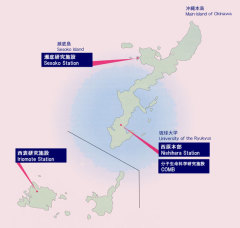Outline
History
The sea around the Ryukyus, characterized by coral reefs and mangroves developing under the influence of warm Kuroshio Current, is regarded as representing the northernmost extremity of the tropical zone. Although the area borders the temperate waters around the main-islands of Japan, it accommodates a much higher biodiversity characteristic of tropical waters.
The University of the Ryukyus is the southernmost national university in Japan, and enjoys an advantageous location for the long term in-situ studies. In response to the academic and social requirements mentioned above, The Tropical Biosphere Research Center (TBRC) was established in 1994 as a Joint-Use Research-Institute attached to the university. The main objective of the center is to promote broad based research activities on the diversity of our tropical biota and related environmental influences.
Iriomote Station was founded as a branch station of the University of the Ryukyus Faculty of Agriculture in 1971 and was integrated into the Tropical Biosphere Research Center upon its establishment in 1994.
The TBRC consists of three facilities - Nishihara Station, Sesoko Station and Iriomote Station. Nishihara Station is in the main campus of the university which is located in the southern part of Okinawa-Honto (the main-island of Okinawa). Sesoko Station stands on Sesoko Island, an islet off the northern part of Okinawa-Honto. Itiomote Station is located on Iriomote Island, about 430 km southwest of Okinawa-Honto.
In 2009, the TBRC has been combined with Center of Molecular Biosciences (COMB), and the research area has been extended to include functional genomics, molecular biotechnology, bioremedeiation, and molecular microbiology with increase in the number of staff members.
The University of the Ryukyus is the southernmost national university in Japan, and enjoys an advantageous location for the long term in-situ studies. In response to the academic and social requirements mentioned above, The Tropical Biosphere Research Center (TBRC) was established in 1994 as a Joint-Use Research-Institute attached to the university. The main objective of the center is to promote broad based research activities on the diversity of our tropical biota and related environmental influences.
Iriomote Station was founded as a branch station of the University of the Ryukyus Faculty of Agriculture in 1971 and was integrated into the Tropical Biosphere Research Center upon its establishment in 1994.
The TBRC consists of three facilities - Nishihara Station, Sesoko Station and Iriomote Station. Nishihara Station is in the main campus of the university which is located in the southern part of Okinawa-Honto (the main-island of Okinawa). Sesoko Station stands on Sesoko Island, an islet off the northern part of Okinawa-Honto. Itiomote Station is located on Iriomote Island, about 430 km southwest of Okinawa-Honto.
In 2009, the TBRC has been combined with Center of Molecular Biosciences (COMB), and the research area has been extended to include functional genomics, molecular biotechnology, bioremedeiation, and molecular microbiology with increase in the number of staff members.

Main Research Building

3 facilities of the TBRC
IRIOMOTE IS.
Iriomote island is located about 430 km southwest from Okinawa mainland at 24 degrees north and 123 degrees east. The second largest island in Okinawa prefecture after the mainland with 284 square kilometers land. 34.3% of the island is the Iriomote National Park. The average annual temperature 23.4 degrees and the average annual precipitation is 2,342 mm.
Its subtropical climate supports a coastal fringe of mangroves with inland broad-leaved forests. It also supports a number of species of indigenous animals, such as the Iriomote Wildcat – Feris Iriomotensis, KANMURIWASHI (crown eagle) – Spilornis cheela which are designated as natural monuments and so on.
Its subtropical climate supports a coastal fringe of mangroves with inland broad-leaved forests. It also supports a number of species of indigenous animals, such as the Iriomote Wildcat – Feris Iriomotensis, KANMURIWASHI (crown eagle) – Spilornis cheela which are designated as natural monuments and so on.

Mangroves of Funaura Bay

KANMURIWASHI Spilornis cheela
EDUCATION / RESEARCH
The Iriomote Station includes three research sections:
1. Section of Forest Resource Science
2. Section of Functional Physiology of Bioresources
3. Section of Applied Plant Science
The station has been playing a central role as a research base or station for the study of mangrove ecosystems.
Also the station has several cooperative research programs with international and Japanese researchers. The station also provides facilities for research projects by outside researchers and is also involved in various training courses organized by Japan International Cooperation Agency (JICA).
Iriomote Station conducts intensive courses for undergraduate and graduate students. The geographic advantage is beneficial to students in both education and research by providing an “in-situ class” with actual organisms in their natural habitats.
1. Section of Forest Resource Science
2. Section of Functional Physiology of Bioresources
3. Section of Applied Plant Science
The station has been playing a central role as a research base or station for the study of mangrove ecosystems.
Also the station has several cooperative research programs with international and Japanese researchers. The station also provides facilities for research projects by outside researchers and is also involved in various training courses organized by Japan International Cooperation Agency (JICA).
Iriomote Station conducts intensive courses for undergraduate and graduate students. The geographic advantage is beneficial to students in both education and research by providing an “in-situ class” with actual organisms in their natural habitats.

Fieldworks in mangroves
FACILITY
The facilities of the station, including the dormitory, are available to international and domestic researchers and students.
A two-storied dormitory is available for all research visitors. It is also used to lodge the participants of courses and meetings. The dormitory is capable of accommodating 10 researchers and 40 students.
A two-storied dormitory is available for all research visitors. It is also used to lodge the participants of courses and meetings. The dormitory is capable of accommodating 10 researchers and 40 students.

Glass house

Cafeteria
